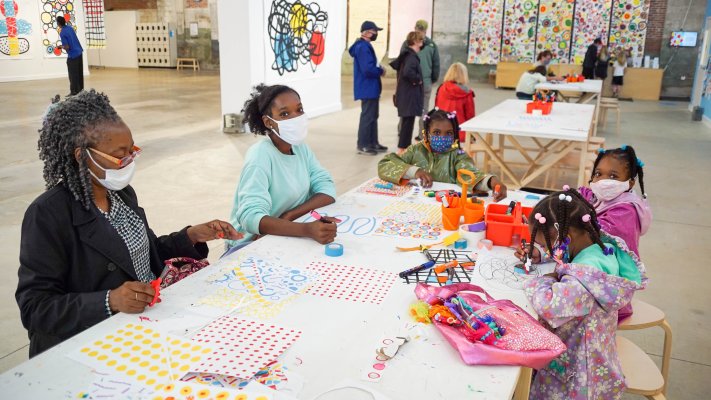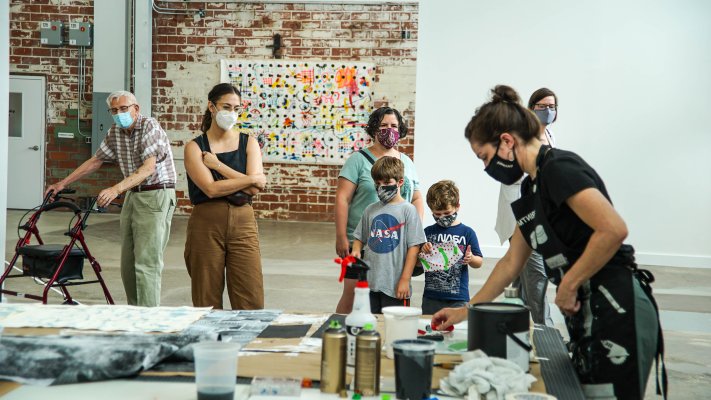Hervé Tullet: Shape and Color is the largest exhibition of work by this artist, performer, and beloved children’s book author ever assembled. The exhibition also includes spaces for artmaking and artist residencies. Today we are highlighting the artist who inspired this unique exhibition—Hervé Tullet.
For many artists, the blank page, the empty canvas at the beginning of any work can be frightening, threatening—even mocking. For Hervé Tullet, it represents only freedom, opportunity, and discovery.
Tullet is an artist compelled to make constantly. His art overflows with seemingly simple ideas and gestures that lend themselves naturally to works brimming with joy and movement. Tullet traces his own practice through a wide variety of styles, engaging what suits his whims while eliminating what’s irrelevant. There are elements of collage and bricolage from the Cubists, the directness of Art Brut, the play of Fluxus, the contemplation of Conceptualism, and the invitation to participate extended by Social Practice. But Tullet is interested in these traditions for the tools they offer rather than the limits they might impose.
Tullet’s success and popularity as a children’s book author has led some critics to assume—mistakenly—that his audience is only the young and to brand his work “childlike.” However, this label disregards the art historical impact of “untrained” artists, like those directly influenced by Art Brut. It also radically underestimates the inherent value found in the creative freedom of a child’s mind.
In his 1927 book Children’s Drawings, the pioneering scholar of children’s art Georges-Henri Luquet wrote, “Children draw for fun. For them drawing is just like other games and is interspersed among them.” When we follow the lead of children, “childlike” becomes celebratory, and we discover some of the unadulterated play and joy of making. It can also allow us to pay more attention not to outcomes but to the act of creation. What is important to Tullet is the chance and spontaneity at work while composing: his subject is the creative process itself.
Tullet’s studio is a creative laboratory. Like an alchemist, Tullet takes simple elements—primary colors, simple shapes, spontaneous gestures—and through aggregation and experimentation assembles works that explore and redefine our sense of creative capacity. The lines, dots, splotches, and dabs that define the core of Tullet’s visual vocabulary reflect a confident yet curious hand, thoughtfully focused mind, and discerning eye. Emotionally aware and with an instinct for mark-making, Tullet’s work offers us a kind of nourishment by embracing the innate creative spirit in all of us, regardless of culture or status.
Tullet’s practice is not an isolated endeavor but is inspired and activated by interaction with others. Just as Albright-Knox Northland has become a space for artmaking, Tullet engages his audiences by offering them access to his techniques. A truly inspirational artist, speaker, and performer, he encourages audiences to become cultural producers of their own, and his workshops all over the world have involved hundreds of people at once.
In this way, he is a kind of magician-teacher. Yet no sleight of hand is at play and no illusion transpires. What takes shape rises from intuition, an interest in chance, play, and even a bit of chaos. The often-remarkable results are unpredictable and unforeseen. Tullet proves that when our magic—our unshackled capacity for creativity—is embraced, especially through community and play, the results are a shared experience far greater than the sum of its parts.
To share Tullet’s spirit, we’ve turned Albright-Knox Northland into a laboratory of our own, with opportunities to play, create, and participate in artmaking. We’ve also made the museum an open studio, where local resident artists are sharing their techniques and constructing murals on Polytab that will later be installed down the street at 714 Northland Avenue.

Artmaking in the special exhibition Hervé Tullet: Shape and Color at Albright-Knox Northland, July 17, 2021. Photo: Jeff Mace for Albright-Knox Art Gallery, Buffalo, New York

Resident artist Rachel Shelton working on her Polytab mural at Albright-Knox Northland, July 10, 2021. Photo: Jeff Mace for Albright-Knox Art Gallery, Buffalo, New York
We invite you to see and experience Tullet’s work, to create your own art, and to interact with our current resident artists—Max Collins, Fotini Galanes, and Phyllis Thompson—from August 13 to September 1. In order to ensure a safe environment for all, we encourage you to review our Courtesy Code and reserve your visit date and time prior to your arrival.
